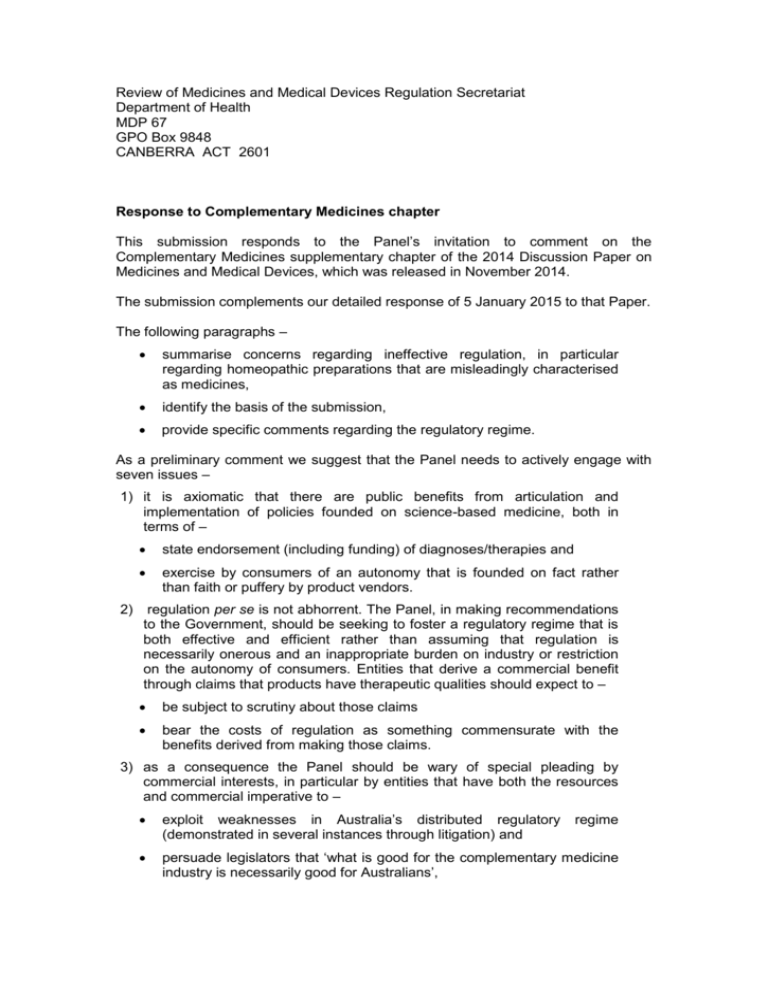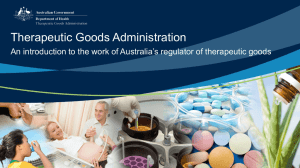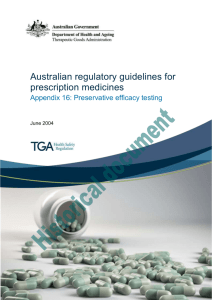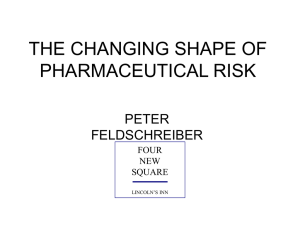Review of Medicines and Medical Devices Regulation
advertisement

Review of Medicines and Medical Devices Regulation Secretariat Department of Health MDP 67 GPO Box 9848 CANBERRA ACT 2601 Response to Complementary Medicines chapter This submission responds to the Panel’s invitation to comment on the Complementary Medicines supplementary chapter of the 2014 Discussion Paper on Medicines and Medical Devices, which was released in November 2014. The submission complements our detailed response of 5 January 2015 to that Paper. The following paragraphs – summarise concerns regarding ineffective regulation, in particular regarding homeopathic preparations that are misleadingly characterised as medicines, identify the basis of the submission, provide specific comments regarding the regulatory regime. As a preliminary comment we suggest that the Panel needs to actively engage with seven issues – 1) it is axiomatic that there are public benefits from articulation and implementation of policies founded on science-based medicine, both in terms of – 2) state endorsement (including funding) of diagnoses/therapies and exercise by consumers of an autonomy that is founded on fact rather than faith or puffery by product vendors. regulation per se is not abhorrent. The Panel, in making recommendations to the Government, should be seeking to foster a regulatory regime that is both effective and efficient rather than assuming that regulation is necessarily onerous and an inappropriate burden on industry or restriction on the autonomy of consumers. Entities that derive a commercial benefit through claims that products have therapeutic qualities should expect to – be subject to scrutiny about those claims bear the costs of regulation as something commensurate with the benefits derived from making those claims. 3) as a consequence the Panel should be wary of special pleading by commercial interests, in particular by entities that have both the resources and commercial imperative to – exploit weaknesses in Australia’s distributed regulatory (demonstrated in several instances through litigation) and persuade legislators that ‘what is good for the complementary medicine industry is necessarily good for Australians’, regime 2 promote spending on complementary products that are therapeutically unnecessary or inefficacious. 4) the market for complementary products and services should be considered on a holistic basis rather than solely in terms of the Therapeutic Goods Act 1989 (Cth) and potential action by the Therapeutic Goods Administration (TGA). Effective regulation includes action by the Australian Competition & Consumer Commission (ACCC) and other entities under the Australian Consumer Law and industry codes. Such codes should be more closely aligned to consumer interests, given recurrent indications that they embody regulatory capture by industry and from a public policy perspective are thus suboptimal.1 5) there is substantial concern within the legal and medical communities regarding regulatory arbitrage, with confusion about demarcations between the TGA, ACCC and entities such as FSANZ in relation to the promotion and oversight of ‘wellness’ products. Those concerns are likely to increase with the movement to a trans-Tasman food safety and pharmaceutical regulation regime and an uncritical acceptance on the part of the TGA of quality standards in jurisdictions such as India.2 There is also concern regarding the willingness of some commercial entities to game the system through oppressive litigation and rebadging of products that have been the subject of legitimate objections regarding advertising.3 6) that arbitrage is reflected in regulatory incapacity on the part of the Therapeutic Goods Administration (TGA) and entities concerned with the advertising of what are characterised as complementary products, highlighted in the preceding submission. 7) finally, the legislation embodies a fundamental conceptual flaw by characterising homeopathic preparations – ie products in which there is no (and by definition cannot be) discernable therapeutically active agent – as medicines. The time has come for a fact-based revision of the legislation. Given the emphasis on consumer autonomy expressed above we do not seek to prevent people from vending/using homeopathic products, in the same way that we do not seek to prevent people relying on tarot cards or the ouija board. Several recent studies have failed to demonstrate any evidentiary basis for homeopathy.4 Until such evidence is uncovered, 1 See for example Ken Harvey, Viola S. Korczak, Loretta J. Marron and David B. Newgreen, ‘Commercialism, choice and consumer protection: regulation of complementary medicines in Australia’ (2008) 188(1) Medical Journal of Australia 21; Ken Harvey, ‘A review of proposals to reform the regulation of complementary medicines’ (2009) 33(2) Australian Health Review 279; Ian Bartle and Peter Vass, ‘Self-Regulation Within The Regulatory State: Towards A New Regulatory Paradigm (2007) 85(4) Public Administration 885. 2 Note Meera Kay, ‘Indian generics manufacturer Ranbaxy agrees to pay $500 m to settle US fraud and drug safety charges’ (2013) 346 BMJ f3536. The unresponsiveness of the TGA, in contrast to the US Food & Drug Administration, appears to be consistent with problems identified in a succession of inquiries into the TGA. 3 John Dowden, ‘Critical appraisal: court in the Act’ (2012) 35(2) Australian Prescriber 38; Jonathan Wardle, Michael Weir, Brenda Marshall and Eloise Archer, ‘Regulatory and legislative protections for consumers in complementary medicine: Lessons from Australian policy and legal developments’ (2014) 6(4) European Journal of Integrative Medicine 423; Anthony Smith, ‘The Efficacy of Complementary Medicines: Where Is The Evidence?’ (2012) 42(3) Journal of Pharmacy Practice and Research 174 4 See for example National Health & Medical Research Council (2015) Statement and advice on 3 homeopathy should not be regarded as medicine and should accordingly not be recognised as a medicinal product under the Therapeutic Goods Act 1989 (Cth). Its continued recognition grants it a veneer of efficacy in the public perception which is inconsistent with the TGA’s role in evaluating complementary medicines. The body of the Discussion Paper refers to “shared understanding” about the regulation of medicines and medical devices. The number of submissions from Complementary Medicines Australia and individual complementary product vendors, practitioners or enthusiasts is not an authoritative metric of understanding. We suggest that the Panel should be wary of unsubstantiated claims by entities with a commercial interest that there is a consensus regarding the – therapeutic efficacy of complementary medicines (or ‘holistic’ diagnostic and therapeutic practice) as a whole or the efficacy of particular products effectiveness of the current co-regulatory regime necessity to further weaken regulation. Instead, it is relevant to note – the absence of credible data regarding the efficacy of homeopathic products, recurrently highlighted by authoritative Australian and overseas government and academic studies examining homeopathic products and practice recurrent independent studies questioning both the marketing and need consumption of complementary products that are variously characterised as vitamins, diet supplements, wellness products, nutraceuticals and cosmaceuticals. controversy over claims by some complementary product vendors, including scepticism about some peer-reviewed studies that ostensibly validate promotional statements regarding therapeutic qualities of specific products judicial and professional disquiet about both the preparedness of some complementary product providers to ‘game the system’ and responses on the part of regulators that do not provide a substantive deterrent to inappropriate marketing. In making the above comments we note that restriction of pseudo-therapeutic preparations and practices is permissible under Commonwealth and state/territory law, ie is not an impermissible restriction on the implied freedom of political communication. Restriction is consistent with the Australian Consumer Law (ie Sch 2 of the Competition & Consumer Act 2010 (Cth)) and more broadly with law regarding unconscionability and fraud. homeopathy; National Health & Medical Research Council (2014) draft Information Paper: Evidence on the effectiveness of homeopathy for treating health conditions and accompanying Effectiveness of Homeopathy for Clinical Conditions: Evaluation of the Evidence – Overview Report, Effectiveness of Homeopathy for Clinical Conditions: Evaluation of the Evidence – Review of Submitted Literature; and UK House of Commons Science & Technology Committee (2010) Homeopathy Inquiry Report. Note also Australian Competition and Consumer Commission v Homeopathy Plus! Australia Pty Limited [2014] FCA 1412. 4 Basis of the Submission The submission is made by Assistant Professor Bruce Baer Arnold and Assistant Professor Dr Wendy Bonython, both of the Law School at the University of Canberra. Both authors are members of the University of Canberra Health Research Institute. Assistant Professor Arnold teaches intellectual property, privacy and competition and consumer law. He has published widely on the Australian patents and competition regimes. His work has been cited with approval by a range of law reform bodies and parliamentary committees. He is a member of two OECD working parties. Assistant Professor Dr Bonython teaches health law and tort law. She has published widely on tort and health law. Her work has been cited with approval by a range of law reform bodies and parliamentary committees. It is informed by postgraduate qualifications in law and science, specifically biochemistry, genetics, and cellular and molecular biology. The submission does not present what would be reasonably construed as a conflict of interest. The submission reflects the authors’ research into Australian and overseas frameworks for the regulation of medical devices and pharmaceuticals. That research is evident in presentations at leading academic conferences, participation in Australian Competition & Consumer Commission consultations regarding the Medicines Australia Code, submissions to the TGA and parliamentary committees, and publication in leading peer-reviewed journals. The submission also reflects an awareness of Australian statute/case law and coregulatory frameworks, for example the Medicines Australia Code under the Competition & Consumer Act 2010 (Cth) and the Therapeutic Goods Advertising Code 2007. As with our more detailed earlier submission we would be pleased to assist the Panel by providing further information or clarification of issues as necessary. The Review The regulatory framework for complementary medicines – the focus of chapter 9 of the current review – involves a distributed co-regulatory regime that involves several statutes and delegated legislation, several national government agencies and private sector bodies. It is not solely a matter of the Therapeutic Goods Act 1989 (Cth) and the Therapeutic Goods Regulations 1990. Instead it encompasses regulation under the Australian Consumer Law (ACL) centred on the Competition & Consumer Act 2010 (Cth) and industry codes regarding product promotion and registration. It coexists with frameworks regarding registration and supervision of health service practitioners, including practitioners of alternative medicine. The regime should be considered holistically rather than on a regulatory silo by silo basis or in terms of the Therapeutic Goods Regulations 1990 to the exclusion of other law. It requires a recognition of decreased regulatory capacity among the TGA’s peers (evident in statements by India’s regulator regarding inability to address problems with fraud, corruption and egregious disregard of quality standards in pharmaceutical manufacture) and the impact of free trade agreements such as the TransPacific Partnership Agreement. 5 It also requires attention to historic anomalies such as enshrining homeopathic and certain aromatherapy preparations in the Therapeutic Goods Regulations 1990 as medicines. Such products should not be validated as medicines (ie as therapeutic) and should instead be more properly – and in terms of the TGA’s resources more effectively – addressed under common law and the Australian Consumer Law by the ACCC and other regulators. Questions Responses in relation to specific queries are as follows – Given the apparent differences in the definition of complementary medicines internationally and the level of pre-market assessment that they undergo, how might Australia determine ‘trusted’ regulators for the purpose of undertaking assessments of ingredients for use in listed products in Australia? If a criteria based approach were to be adopted, what criteria should apply in determining whether an overseas regulator is ‘trusted’ for the purpose of undertaking assessments of ingredients for use in listed products in Australia? This question appears to be conflating several discrete issues. Firstly, it presupposes that all Australian stakeholders have consistent perceptions about what ‘regulation’ of complementary medicines in Australia is. Given the widespread confusion about the efficacy of some locally made products already on the market, it would be prudent to start any reform with an engagement strategy to advise the public that regulation means that a product has been assessed as safe, rather than necessarily effective, if indeed it has undergone any assessment at all. Following on from that, it would be advisable to consider what criteria should be applied to determine whether an overseas regulator is ‘trusted’, noting that these criteria may depend on the context of the assessment. More stringent criteria may be appropriate in considering ingredients not previously approved for release in the Australian market – indeed it could be argued that for these ingredients, Australia should maintain its own assessment capacity. If, however, the product under consideration is simply a formulation of known ingredients, which has been assessed elsewhere as safe, the criteria applied to determine whether an international counterparts assessment is sufficient may be quite different. Regardless, the identity of the counterpart, and their mechanisms for post-approval surveillance and enforcement should feature strongly in all criteria. It would be politically unpalatable for a country with a poor track record in food standards or pharmaceutical standards to hold ‘trusted’ status, for example; conversely, there are a number of countries with pharmaceutical regimes similar to ours where it might conceivably be appropriate to simply accept their verification of a particular complementary medicine, provided that any foreseeable risk attached to such a good was low. Should an ingredient only be considered to have been ‘approved’ by an overseas regulator if it has been subjected to some form of assessment? Yes If yes: Should this assessment include quality, safety and efficacy? 6 The assessment should definitely include quality and safety; whether it includes efficacy will depend entirely on how the TGA (or another regulator) chooses to identify its role to the public. If the public perception is that the ingredient is effective, because it has regulatory approval, then the assessment of any overseas regulator must include efficacy; if, however, the regulator takes steps to ensure consumers are aware that regulatory approval only relates to safety, and not efficacy, then requiring efficacy assessments is far less important. Should evidence standards be comparable with, or superior to, those currently applying in Australia? Standards should be superior to those currently in place; the number of noncompliant products, and the lackadaisical approach of some suppliers to compliance issues is a cause for concern. Regulation should be performed for a reason: if a good poses no, or very low, risk, regulation should be minimal. Indeed, for many items within this category, in the absence of assessment for efficacy, it is questionable whether they would be better regulated by other organisations as foodstuffs, noting that some of the more likely risks (i.e allergic reactions due to traces of certain products) comparably arising in foodstuffs are already dealt with through existing regulatory frameworks. By rationalising the regulatory burden to better reflect the risk posed by certain products, more resources could be allocated by the TGA to post market surveillance, enhanced assessment of applications, and enforcement of non-compliance associated with higher risk products, more rightly within the TGA’s scope. If Australia were to adopt approvals of ingredients provided by ‘trusted’ overseas regulators, what additional assessment, if any, should be conducted by the Australian regulator? If such a process is adopted, there needs to be a mechanism in place whereby adverse events occurring anywhere (not just in Australia) are reported immediately to the TGA (or other regulatory body). Such a mechanisms needs to allow the regulator to conduct its own assessment, and either withdraw or suspend the product from the market pending the outcome of that assessment. Such an assessment should also be accompanied by due diligence performed against the applicant, i.e. how reliable are they at reporting adverse events? How good are the quality control and recall mechanisms in the event of an adverse event? What business provisions (liability insurance) do they have in place to respond to such an event? What value do you believe an assessment by the TGA adds in cases where such an assessment has already been undertaken by a ‘trusted’ overseas regulator? The mechanisms outlined above are specific to the Australian legal framework; as such they cannot be performed adequately by an overseas agency. Are there aspects of safety or quality that need to be considered in the Australian context? If so, what aspects? Potentially; there are some variations in consumer population characteristics, environment, and ingredients which may affect the safety and quality of certain goods. Examples might include storage and shelf life of goods, different 7 concentrations of active ingredients within certain plant sourced materials, and susceptibility of the population to certain allergens not encountered elsewhere. How might evidence requirements for listing on the ARTG and for advertising pre-approval of complementary medicines be harmonised? What changes to evidence requirements would be required? The two sets of standards are asking different questions: the advertising standards are assessing whether the claims made in advertising are false and misleading, whereas pre-approval evidence supports the indications- purposes for which the product can be used. If the claims made are indirectly related to the purpose, then the evidence for the two is unlikely to be sufficiently similar. Is the current regulatory regime for complementary medicines in Australia appropriate and commensurate with the risk posed by these products? If not, why not? Should complementary medicines in Australia be regulated under a separate legislative framework? If yes, what should be the key features of the framework? Risk should be a key determinant of how stringent the regulation is. Many of the products currently captured under the definition are comparable to foodstuffs in terms of the risk they present, not pharmaceuticals. As such, it is inappropriate that they be regulated in the same way as pharmaceuticals. These low risk products may be better regulated under a separate framework, especially if all their active constituent ingredients have previously been evaluated and approved. Should low-risk complementary medicines be regulated as general consumer goods, removing the requirement for listing on the ARTG? If yes, why? If not, why not? What criteria should be used to determine whether a complementary medicine should be regulated as a therapeutic good? Yes, these products should be regulated as general consumer goods. There is already an extensive body of law regulating the sale of goods, including their marketing, overseen by the ACCC. These goods don’t pose any special risk above and beyond those routinely found in other consumer goods. Arguably the greater harm comes from involving the TGA in their regulation, which conveys the impression that they are more tightly regulated and assessed for safety quality and efficacy than is necessarily the case, regardless of whether or not such assessment is actually required. That involvement furthermore diverts the TGA from direct examination of pharmaceuticals and medical devices (two areas where failures have both imposed fundamental costs on consumers and the broader health system) and verification of the effectiveness of overseas peers (another matter where the TGA has been indifferent to legitimate criticism regarding incapacity in dealing with substantive problems in India). Should certain dietary supplements, such as water soluble vitamins, be regulated as foods or as general consumer goods rather than as therapeutic goods? If not, why not? What is the rationale for continuing to regulate these products as therapeutic goods? If yes, should such goods be regulated as foods or consumer goods? 8 Foods. In some instances there may be risks comparable with those commonly encountered in foodstuffs ie contamination with allergens, contraindications, etc. Similarly, nutrition information labelling is appropriate for goods of this type. Some protection through regulation and warnings is required, but not full regulation as a foodstuff. What criteria should be applied to determine whether a product should continue to be regulated as a therapeutic good? Making of specific claims of therapeutic benefit should be a trigger for regulation as a therapeutic good; it goes directly to the issue of efficacy and evidence of therapeutic benefit, which are the kinds of issues on which the TGA should be regulating.




